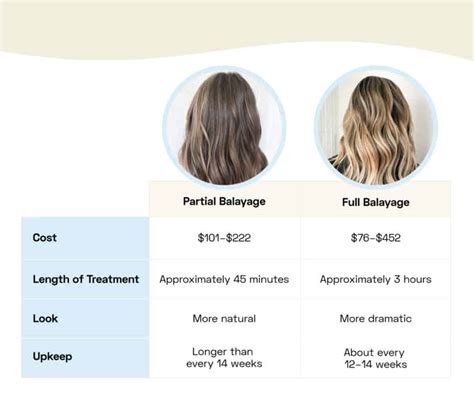When it comes to illuminating your locks with captivating highlights, balayage stands out as a technique that mimics the sun-kissed brilliance of natural beachy hair. However, the level of transformation you desire will determine whether a partial or full balayage is the ideal choice for you. This comprehensive guide delves into the nuances of each option, empowering you with the knowledge to make an informed decision.

Partial Balayage: Subtle Radiance with Less Commitment
Partial balayage, also known as demi-balayage, focuses on strategically highlighting specific areas of your hair, typically framing the face and adding depth and dimension to the mid-lengths. This technique is ideal for those seeking a gradual change or a subtle enhancement to their current hair color.
Benefits:
- Low maintenance with touch-ups required less frequently
- Adds a natural-looking glow without drastic alteration
- Suitable for both short and long hair lengths
Full Balayage: A Transformative Canvas for Daring Expressions
Unlike partial balayage, full balayage applies highlights throughout the entire head of hair, from root to tip. This technique offers a more dramatic transformation, allowing you to experiment with bolder color combinations and create a high-impact statement.
Benefits:
- Unparalleled versatility for customization and creativity
- Creates a multifaceted blend of tones, adding depth and texture
- Ideal for those seeking a significant color change
Understanding the Differences:
| Characteristic | Partial Balayage | Full Balayage |
|---|---|---|
| Area of Coverage | Specific areas, typically framing the face and mid-lengths | Entire head of hair, from root to tip |
| Transformation Level | Subtle enhancement | Dramatic transformation |
| Maintenance | Low maintenance, touch-ups as needed | Requires regular touch-ups to maintain desired color |
| Suitability | Short to long hair lengths | Best suited for medium to long hair lengths |
Choosing the Right Option for Your Needs:
To determine the optimal balayage approach, consider the following factors:
Hair Type and Length:
Partial balayage suits fine or thin hair, as it adds volume and movement without overwhelming the strands. Full balayage is more suitable for thicker or longer hair, as it provides more coverage and control.
Desired Transformation Level:
If you prefer a subtle enhancement or seek to maintain a significant portion of your natural hair color, partial balayage is a great choice. For a dramatic transformation or a complete color overhaul, full balayage offers greater flexibility.
Maintenance Considerations:
Partial balayage requires less maintenance, with touch-ups typically needed every 4-6 months. Full balayage requires more frequent touch-ups, typically every 2-3 months, to maintain the desired color and vibrancy.
Step-by-Step Approach:
The balayage technique involves a multi-step process that requires precision and skill.
Partial Balayage:
- Section off the hair into layers.
- Select strands in the desired areas (e.g., face-framing, mid-lengths).
- Apply lightener to the selected strands using a sweeping motion.
- Process the lightener according to the manufacturer’s instructions.
- Tone the hair to achieve the desired color.
Full Balayage:
- Section off the hair into smaller sections.
- Backcomb the hair at the roots to create a feathered effect.
- Apply lightener to the backcombed sections.
- Process the lightener according to the manufacturer’s instructions.
- Remove the lightener and tone the hair to achieve the desired color.
Cost Considerations:
The cost of balayage varies depending on the length of your hair, the level of transformation desired, and your location.
| Hair Length | Partial Balayage | Full Balayage |
|---|---|---|
| Short | $150-$300 | $250-$400 |
| Medium | $200-$400 | $300-$500 |
| Long | $250-$500 | $350-$600 |
Pain Points and Motivations:
Pain Points:
- Potential for hair damage if not performed correctly
- Can be time-consuming, requiring multiple sessions
- May not be suitable for all hair types or colors
Motivations:
- Desire for a natural-looking color transformation
- Adds volume and texture to the hair
- Can enhance facial features and brighten the complexion
Strategies for Effective Balayage:
- Seek a skilled and experienced hairstylist who specializes in balayage techniques.
- Communicate your desired outcome clearly to ensure proper execution.
- Use high-quality hair care products specifically designed for color-treated hair.
- Protect your hair from sun damage with UV protectants.
Conclusion:
The choice between partial and full balayage ultimately hinges on your personal preferences and hair goals. If you seek a subtle enhancement or require less maintenance, partial balayage is a suitable option. For a more dramatic transformation and artistic expression, full balayage offers unparalleled versatility. By understanding the intricacies of each technique, you can confidently embark on a balayage journey that illuminates your hair with captivating radiance.
Additional Considerations:
Ombré Balayage:
Combines balayage with ombré techniques to create a graduated fade from dark roots to lighter ends.
| Characteristic | Balayage | Ombré Balayage |
|---|---|---|
| Coverage | Highlights throughout the hair | Gradually transitions from dark to light |
| Placement | Hand-painted, free-form application | More defined sections, typically with a horizontal line |
| Root Coverage | Partial coverage or exposed roots | Darker roots are maintained |
Ecaille Balayage:
Inspired by tortoise shell patterns, this technique creates a harmonious blend of warm and cool tones, mimicking the natural color variation of tortoise shells.
| Characteristic | Balayage | Ecaille Balayage |
|---|---|---|
| Color Palette | Typically uses varying shades of one color | Combines warm and cool tones for a multi-dimensional effect |
| Placement | Hand-painted, free-form application | Concentrated in the mid-lengths and ends, creating a shell-like pattern |
| Inspiration | Natural beachy hair | Tortoise shell patterns |
